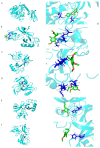Exploration of the Mechanisms of Acorus tatarinowii in the Treatment of Major Depressive Disorder Based on Network Pharmacology and Molecular Docking Techniques
- PMID: 40699741
- PMCID: PMC12109585
- DOI: 10.3390/cimb47050342
Exploration of the Mechanisms of Acorus tatarinowii in the Treatment of Major Depressive Disorder Based on Network Pharmacology and Molecular Docking Techniques
Abstract
Objective: To elucidate the molecular targets and mechanisms by which Acorus tatarinowii exerts therapeutic effects in major depressive disorder (MDD) using network pharmacology and molecular docking approaches.
Methods: Bioactive compounds of Acorus tatarinowii were identified from comprehensive pharmacological databases. MDD-related targets were sourced from extensive genomic repositories. Overlapping targets were determined and subjected to network topology and protein-protein interaction (PPI) analyses to identify core targets. Gene Ontology (GO) and Kyoto Encyclopedia of Genes and Genomes (KEGG) pathway enrichment analyses were performed to reveal pertinent biological processes and signaling pathways. Molecular docking simulations validated the interactions between key bioactive compounds and core targets.
Results: A total of 57 bioactive compounds were identified in Acorus tatarinowii, including apigenin, heterotropan, and isoelemicin. Integrative analysis revealed 700 compound-related targets and 2590 MDD-associated targets, with 150 intersecting targets. Network analyses pinpointed five core targets: TP53, STAT3, AKT1, PIK3CA, and PIK3R1. GO enrichment identified 858 significant biological processes, while KEGG pathway analysis highlighted 155 enriched pathways, notably the PI3K-Akt, cAMP, and MAPK signaling pathways. Molecular docking studies demonstrated strong binding affinities between key compounds and their respective targets.
Conclusions: This study delineates the multifaceted polypharmacological mechanisms through which Acorus tatarinowii may confer protective effects against major depressive disorder, underscoring its potential as a promising therapeutic agent.
Keywords: Acorus tatarinowii; major depressive disorder; molecular docking; network pharmacology.
Conflict of interest statement
The authors declare no conflicts of interest.
Figures






Similar articles
-
Elucidating the Mechanism of Xiaoqinglong Decoction in Chronic Urticaria Treatment: An Integrated Approach of Network Pharmacology, Bioinformatics Analysis, Molecular Docking, and Molecular Dynamics Simulations.Curr Comput Aided Drug Des. 2025 Jul 16. doi: 10.2174/0115734099391401250701045509. Online ahead of print. Curr Comput Aided Drug Des. 2025. PMID: 40676786
-
Revealing the Multi-Target Mechanisms of Fespixon Cream in Diabetic Foot Ulcer Healing: Integrated Network Pharmacology, Molecular Docking, and Clinical RT-qPCR Validation.Curr Issues Mol Biol. 2025 Jun 25;47(7):485. doi: 10.3390/cimb47070485. Curr Issues Mol Biol. 2025. PMID: 40728954 Free PMC article.
-
Sheng-ji Hua-yu Formula promotes diabetic ulcer healing via regulating the cAMP/PKA/CREB signaling pathway.J Ethnopharmacol. 2025 Jul 24;351:120105. doi: 10.1016/j.jep.2025.120105. Epub 2025 Jun 6. J Ethnopharmacol. 2025. PMID: 40484258
-
Therapeutic mechanisms of Acorus tatarinowii and its bioactive compounds in cardiovascular diseases: A comprehensive review.Phytomedicine. 2025 Sep;145:156988. doi: 10.1016/j.phymed.2025.156988. Epub 2025 Jun 16. Phytomedicine. 2025. PMID: 40578036 Review.
-
Medicine for chronic atrophic gastritis: a systematic review, meta- and network pharmacology analysis.Ann Med. 2023;55(2):2299352. doi: 10.1080/07853890.2023.2299352. Epub 2024 Jan 3. Ann Med. 2023. PMID: 38170849 Free PMC article.
References
-
- Zhang M., Yang Y., Zhao Y., Sui C., Sui Y., Jiang Y., Liu K., Yang S., Wang L., Chen B., et al. The application of integrating electroencephalograph-based emotion recognition technology into brain–computer interface systems for the treatment of depression: A narrative review. Adv. Technol. Neurosci. 2024;1:188–200. doi: 10.4103/ATN.ATN-D-24-00018. - DOI
-
- Yan L., Mahady G., Qian Y., Song P., Jian T., Ding X., Guan F., Shan Y., Wei M. The Essential Oil from Acori Tatarinowii Rhizome (the Dried Rhizome of Acorus tatarinowii Schott) Prevents Hydrogen Peroxide-Induced Cell Injury in PC12 Cells: A Signaling Triggered by CREB/PGC-1α Activation. Evid. Based Complement. Altern. Med. 2020;2020:4845028. doi: 10.1155/2020/4845028. - DOI - PMC - PubMed
Grants and funding
LinkOut - more resources
Full Text Sources
Research Materials
Miscellaneous

